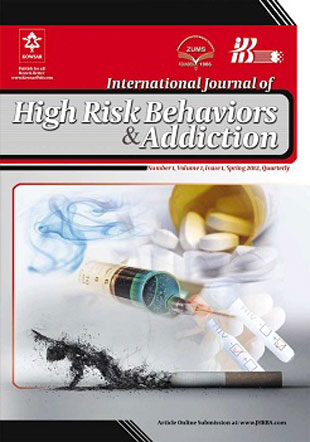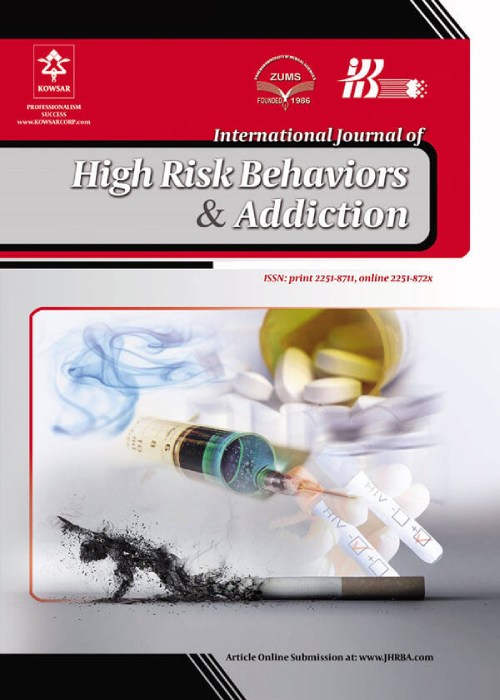فهرست مطالب

International Journal of High Risk Behaviors and Addiction
Volume:1 Issue: 3, Sep 2012
- تاریخ انتشار: 1391/10/29
- تعداد عناوین: 10
-
-
Page 92BackgroundIn recent years, many studies have been conducted to establish the causes of people’s tendency to become addicted and researchers have also tried to determine the amount, importance and role of each individual and environmental factor..ObjectivesWith regard to the inconsistencies in previous research results, this study aims to use meta-analysis in order to integrate the results of different studies and investigate the impact of environmental and personal factors in people’s proclivity to addiction..Materials And MethodsThis meta-analysis uses the Hunter and Schmidt approach. For this purpose, 16 out of 32 studies which were acceptable in terms of their methodology, and had been conducted during an eight year period (2003 - 2010), were selected. A meta-analysis was conducted on the articles which had been collected using a standard checklist via; the internet, in person, telephone and e-mail, from universities and research centers across the country. After summarizing the results of the studies, effect sizes were calculated manually and combined based on a meta-analysis, and interpreted in accordance with a cohen’s table..ResultsAfter data collection, results showed that the effect size of environmental factors in people’s tendency to addiction was 0.61 (P ≤ 0.00001), and the effect size of individual factors in people’s tendency to addiction was 0.45 (P ≤ 0.03)..ConclusionsAccording to cohen’s table size, the effects were evaluated as average to high for the environmental factors and low to moderate for the individual factors in the tendency to become addicted.Keywords: Meta, Analysis, Behavior, Addictive, environmental
-
Page 100BackgroundOpium abuse significantly affects the nutritional status of users and frequently leads to undernourishment. Methadone maintenance therapy has been used as one of the possible ways to prevent of infection diseases such as HIV and hepatitis B and C and improve the quality of life in opioid-dependent patients..ObjectivesThe aim of this study was to assess the anthropometric and socio-demographic characteristics of opium addicted persons before and after Eight weeks of methadone maintenance therapy (MMT)..Patients andMethodsA clinical cross-sectional study was carried out on 55 opium users (15 women and 40 men; mean aged 31.6 ± 10 years), dependent on opium and its derivatives at the Addiction Treatment Clinic of the Baharan psychiatric Hospital, Zahedan, Sistan and Baluchistan Province, Iran, in 2011. The patients were examined before and after eight weeks MMT. Weight and height of participants were taken and the body mass index (BMI) was calculated..ResultsBody weight increased significantly from 61.4 ± 14.4 to 65.3 ± 14.2 kg and BMI from 21.4 ± 4.2 to 23 ± 5.6 (kg/m2) after 8 weeks of methadone maintenance therapy in opium users (P < 0.01). The percentages of underweight, overweight and obese patients were; 27.3%, 18.2% and 3.6%, respectively pre-MMT, and 12.7%, 18.2% and 7.2%, respectively after MMT..ConclusionsThe study shows that methadone Maintenance Therapy led to improvements in nutritional status..Keywords: MMT, Body Mass Index, Population Characteristics, Opium dependency
-
Page 104BackgroundAdult attention deficit hyperactivity disorder (ADHD) increases the risk of several psychiatric disorders, like substance use disorders (SUDs)..ObjectivesThis study aimed to predict the tendency for drug use from child and adult AdHd symptoms in adults among male students from Tabriz University, Iran..Patients andMethodsFor this purpose, 361 students were selected via a stratified random sampling from different faculties of Tabriz University. The students completed the Conners Adult ADHD Rating Scale self-report form and subscale (CAARS) questionnaire, Addiction Acknowledgment Scale (AAS) and MacAndrew Alcoholism Revised-Scale (MACR)..ResultsTo analyze the data Pearson correlation and multiple regressions (step by step) were used. Results indicated that there is a significant relationship between scores on the AAS and MAC-R via child and adult ADHD symptoms (P = 0.01). Moreover, we found that those with the highest addiction acknowledgment (13%) exhibited adult ADHD (total) and child ADHD. Alcohol potential (15%) was related to scores of child ADHD and impulsivity..ConclusionsAccording to this result behavioral disorders, especially AdHd, have an effect on the tendency to use drugs and therefore the primary treatment of behavioral disorders could prevent future drug abuse.Keywords: Adulthood Attention Deficit Hyperactivity Disorder, Substance Abuse, Alcoholism
-
Page 109BackgroundFamily functioning is considered to have a significant impact on the beginnings and maintenance of substance use..ObjectivesThe main purpose of this study was to examine and compare the dimensions of family functioning among addicted and non-addicted individuals..Patients andMethodsIn this cross-sectional study, the study sample consisted of 228 individuals, including 118 addicted and 110 non-addicted subjects. The addicted persons were recruited from patients who attended the Baharan Psychiatric Outpatient Clinic for treatment of substance dependence disorders and 110 non-addicted (normal) individuals who were selected from normal populations (students, staff of the hospital and people accompanying patients without a history of substance use) through convenience sampling. The Family Assessment Device (FAD) was used to assess six dimensions of family functioning. The data were analyzed using descriptive indexes (ie, frequency, mean and standard deviation) and t test..ResultsThe results showed significant differences in the mean scores of family functioning dimensions including; problem solving, communication, roles, affective responsiveness, affective involvement, behavioral control and overall family performance (P < 0.01)..ConclusionsResults of this study confirmed the lower functioning levels of substance dependent clients᾽ families on all subscales of the FAD, than in families of non-addicted individuals. It is therefore concluded, that providing interventional strategies for the prevention and treatment of substance use that focus on and involve families in the delivery of health care services is a necessity.Keywords: Family Functioning, Drug Abuse, FAD
-
Page 115BackgroundFemale circumcision, sexual amputation, or Female Genital Mutilation (FGM) is an action existing in some cultures and regions of the world. For instance, in Africa and some little communities in Middle East use this operation for many reasons. This operation is forbidden in those countries and is never linked to religious attitudes..ObjectivesThe purpose of the following research was to determine and compare marital satisfaction, mental health and sexual satisfaction between Kurdish genital mutilated and non-genital mutilated females..Patients andMethodsTo achieve the goal of research, a sample of 200 married females of Ornament area in Kermanshah province were selected by non-randomized sampling Enrich Marital Inventory, and General Health Questionnaire was used for data gathering. Data was analyzed between the two groups by utilizing independent t- test. The significant level was P < 0.05..ResultsThe findings indicated that there was a significant difference between genital mutilated females and non-genital mutilated females. Besides, the results revealed that two groups of participants had significant difference in mental health and the other subscales like physical symptom and sleep disorder from general health..ConclusionsIt is noteworthy to point out that there is strong relation between sexual desire and marital satisfaction and their fulfillment reflects in mental health of people. So, when women experience the FGM in their lives, in fact they lose the gratification of their whole life. Awareness of the mental and psychical dangerous results of this operation could help women and prevent doing this inhuman action to others..Keywords: Female; Genital Mutilation; Couple Satisfaction; Mental Health
-
Page 121BackgroundObesity is a risk factor that has been associated scientifically with hypertension, diabetes, hyperlipidemia, cancer and other life threatening diseases. The results of some studies have also shown that obesity is an independent risk factor for the development and progression of renal damage..ObjectivesThe aim of the current study is to define which general and central obesity anthropometric indices are better predictors for ceratinine clearance (CC) in healthy, normal and obese Iranian women..Patients andMethodsIn this case-controlled study, a total of 62 healthy, normal and obese women from 18 to 30 years of age in Zahedan City, the Islamic Republic of Iran, were studied. The subjects were classified into two groups; case group (31 subjects) of healthy obese women (30 ≤ BMI ≤ 39.9 kg/m2) and control group (31 subjects) of healthy normal women (18.5 ≤ BMI ≤ 24.9 kg/m2). An assessment of body mass index (BMI) was considered as a general obesity index and an assessment of waist circumference (WC) and waist to hip ratio (WHR) were considered as central obesity indices. A measurement of CC was considered for renal function..ResultsThe means of CC in subjects with increased BMI, WC, and WHR were significantly higher than those in subjects with normal BMI, WC, and WHR. Pearson correlation coefficient revealed that there was a stronger correlation between CC with WC than with WHR and BMI (r = 0.4, P = 0.009; r = 0.4, P = 0.01 in the case and control groups, respectively)..ConclusionsIt is suggested that in clinical practice, WC can be used as a better predictor of CC than WHR and BMI in both normal and obese, healthy women..Keywords: Prevention, Control, Life Style, Renal Insufficiency
-
Page 126BackgroundMethamphetamine (MA) is a highly addictive stimulant which has destructive effects. There is also evidence that methamphetamine use in some females, partly is due to their desire to lose weight. The purpose of this study was to determine the association between family flexibility, food preoccupation and body image among crystal abuser women..ObjectivesThis study tried to evaluate whether food preoccupation, body image and family flexibility affect on crystal abuse in women..Patients andMethodsEighty crystal abuser women were chosen with convenience sampling with convenience sampling and they responded to instrument of body image (Fisher), family flexibility (Olson) and food preoccupation (Tapper) questionnaires..ResultsThere is a significant association between family flexibility and food preoccupation (P < 0.01) and also other variables; there is no significant association between family flexibility and body image, body image and food preoccupation (P > 0.05). Also, family flexibility is prediction of food preoccupation (P < 0.01)..ConclusionsThese results emphasize that the components of eating behaviors (e.g. food preoccupation) and family flexibility can be considered in therapeutic interventions (prevention and treatment) for women to crystal withdrawal..Keywords: Methamphetamine, Drug Abuse, Body Image, Women
-
Page 132BackgroundDrug abuse is a disorder associated with unhealthy pattern of drug consumption and is a widespread social delinquent both in society and at home. There have only been a few studies conducted on the frequency and types of harmful behaviors among drug abusers..ObjectivesThe objective of this study is to investigate the frequency of harmful behaviors in people who are suffering from drug abuse.. Patients andMethodsThe population was comprised of all the patients with drug abuse disorders hospitalized during 6 month from 1389 - 1390 in adult wards of Ibn - Sina Psychiatric Hospital in Mashhad. Of those patients who had been identified as having drug abuse disorder, based on the initial interview by a psychiatrist and a urine drug screening test, 99 subjects were selected as the available sample and were informed of the study and its objectives. In this descriptive study patient’s consent had been taken. In psychotic cases, legitimate guardian consent has been obtained. Furthermore, demographic questionnaire in order to determine the harmful behaviors has been completed. Comorbid psychiatric diagnosis was recorded by a psychiatrist, according to the patients’ records. SPSS software was used to analyze the results and, descriptive statistics such as frequency tables and inferential statistics including the chi-square test were used..Results85 drug abusers (58.5%) have a history of harmful behaviors and 14 persons (14.1%) have not acted out in this manner. Seventy individuals had participated in more than one harmful behavior. The most common harmful behavior has been reported as aggression by force and attack (65.5 %.)..ConclusionsThe most common type of harmful behaviors was “aggression by force and attack”. The next most harmful behavior was defined as the threat of suicide. Clearly, drug abuse was a disorder strongly associated with harmful behaviors..Keywords: Substance Abuse, Dangerous Behavior, Suicide, Aggression


